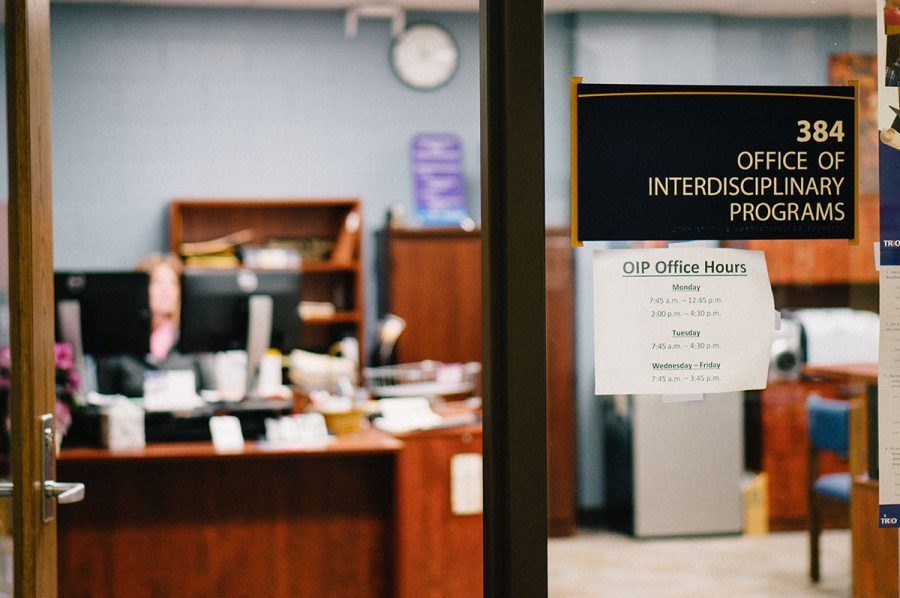Watershed Institute after sitting on foundation of cuts
Academic program looks ahead after feeling impacts of budget cuts
Photo by Amanda Thao
The Office of Interdisciplinary Programs was introduced in the fall of 2015 bringing four programs under the same support staff: the watershed institute, American Indian studies, Latin American studies and women’s studies.
December 14, 2016
This is part of a series where Erickson looks at the effects the 2015-17 budget cuts are having on UW-Eau Claire’s academic departments and its students, faculty and staff. To read first about the other interdisciplinary programs click here.
In some ways the watershed institute has done well as a program, and in others its been challenged, Director James Boulter said of the impacts the 2015-17 state budget cuts have had on the program he directs.
“If we’ve done well it’s because people have really stepped up and said ‘yeah I can do that,’” Boulter said. “…They’re [faculty] always stepping up to meet challenges. This is a different kind of challenge. This is a different magnitude of challenge than this campus has potentially ever seen before.”
The $250 million cut in funding to the UW System’s budget is of great magnitude, Boulter said, because it affects more than just the universities and their academic departments, or interdisciplinary programs, which the watershed institute is one of four.
When asked what he thought of Gov. Scott Walker’s argument that universities needed to economize their operations to become more efficient, Boulter paused for a few quiet seconds before his tone became somber.
“I’ll start larger and then I’ll focus down. I think the argument is a baseless one,” he said calmly. “And I would happily converse with the people making those decisions and refute it.”
Economics show that investments in higher education are returned with increhttps://www.spectatornews.com/campus-news/2016/12/08/where-interdisciplinary-programs-stand-after-budget-cuts/ased state economic health, he said. The UW System is called a public institution, but the state only contributes to 20 percent of the total costs leaving students to pay the rest. Meanwhile, the amount of government oversight over the institution remains strong.
UW-Eau Claire was able to cut its $12 million share with the help of 179 full-time positions lost, according to WPR, 98 of which were faculty and staff who agreed to the early retirement program the university offered.
When a large portion of the loss is in personnel, the workload on each individual goes up and to a certain degree, the quality of the work goes down, Boulter said of his own experiences.
“I assure you I am not as good a teacher right now as I was three years ago. It shows in the level of instruction I am able to do,” he said. “That’s tragic … To know that I am not able to teach as well as I was able to under different circumstances is a huge loss to me personally, but it’s a huge loss to my students as well.”
The watershed program Boulter directs is split between environmental public health (ENPH), which offers an ENPH major, and environmental studies, which offers two minors: environmental science as well as environment, society and culture. The program has five professors with two teaching on each side, while Boulter supports both.
When the program lost one of their ENPH professors due to the buyout, Boulter said that was a third of their ENPH major’s instructional staff gone. This means the usual larger class sizes and less sections offered. It also means remaining faculty are teaching new classes on content out of their expertise, including Boulter.
“Just ask my students,” he said.
Senior ENPH student Breanna Rheinschmidt took his class on radiation health this semester and said he taught the air pollution content like nobody’s business, but the radiation content had been a stretch for him to teach, even as a chemist. She said this reality led to mutual frustrations Boulter had to address to the class.
Rheinschmidt said she and others have also been struggling to get into the biology courses they need, four of which are required for an ENPH degree. But if there’s one change she’s noticed the most over the years, it’s how committed her professor’s have had to become to their students’ education.
“Our professors are listening to students more intensely,” she said. “They’re paying attention to reviews on how to get better and make the classes better.”
On another positive note, Boulter said students in the program are now learning from the perspectives of more professors they wouldn’t have had otherwise. For instance, after Professor Christine Gabel from the program took the buyout, content from one of her ENPH classes was infused into an environmental law class. Boulter said ENPH majors are utilizing classes now taught by environmental studies professor they may not have had otherwise.
Fifth-year student Rachel Kennedy, also majoring in ENPH, said she agrees with Boulter, students on the public health side of the program are taking more courses with environmental professors and gaining access to more perspectives, but it comes at a cost she hasn’t forgotten.
In the midst of the program’s challenges, Kennedy said it can feel ironic when her area of study, which deals with the health, safety and well being of the entire population, isn’t ensured the resources it needs to thrive.

